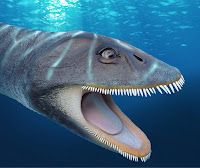 |
| Morturneria seymourensis Chatterjee & Creisler, 1994
O'Keefe, Otero, Soto-Acuña, O'gorman, Godfrey & Chatterjee, 2017.
Cranial Anatomy of Morturneria seymourensis ... |
ABSTRACT
This paper redescribes the holotype skull of the aristonectine elasmosaur Morturneria seymourensis from the upper Maastrichtian of Seymour Island, Antarctica. This description supports the validity of the genus Morturneria, distinct from the genus Aristonectes from Chile and Argentina. The paroccipital process of Morturneria is plesiomorphic, similar to Alexandronectes and unlike the autapomorphic occiput of Aristonectes. The palate of Morturneria is autapomorphic in possessing a strongly developed midline keel. The cranium of Morturneria is about 60% complete and preserves the anterior skull roof and palate; both regions were previously unknown in any aristonectine. The combination of the Morturneria holotype and recent research on other aristonectines allows the first confident cranial reconstruction of an aristonectine elasmosaur. The cranial anatomy of both Morturneria and its close relatives is derived relative to all other plesiosaurs, possessing a novel suite of dental and oral cavity adaptions. The suspensorium extends far behind the occipital condyle, and the jaw is long and hoop-like; together these features allowed a large gape and oral cavity volume. The palate of Morturneria is strongly keeled, forming arched lateral oral chambers that further increased oral cavity volume. The dentition of Morturneria is similar to that of Aristonectes, and all share autapomorphic interlocking combs of needle-like teeth that occluded outside the mouth and did not meet tip to tip. The upper and lower dentition formed an oral battery that may have functioned like a sieve in straining food particles from substrate ejected from the oral cavity. We theorize that this highly derived suite of adaptations is convergent with extant gray whales and archaic mysticetes and hypothesize that it functioned similarly in sieve feeding following suction. This is the first identification of whale-like filter feeding in any marine reptile, a condition once claimed to be anatomically impossible.
F. Robin O'Keefe, Rodrigo A. Otero, Sergio Soto-Acuña, Jose P. O'gorman, Stephen J. Godfrey and Sankar Chatterjee. 2017. Cranial Anatomy of Morturneria seymourensis from Antarctica, and the Evolution of Filter Feeding in Plesiosaurs of the Austral Late Cretaceous. Journal of Vertebrate Paleontology. DOI: 10.1080/02724634.2017.1347570
Plesiosaur fossil found 33 years ago yields new convergent evolution findings http://phy.so/423466634 via @physorg_com




